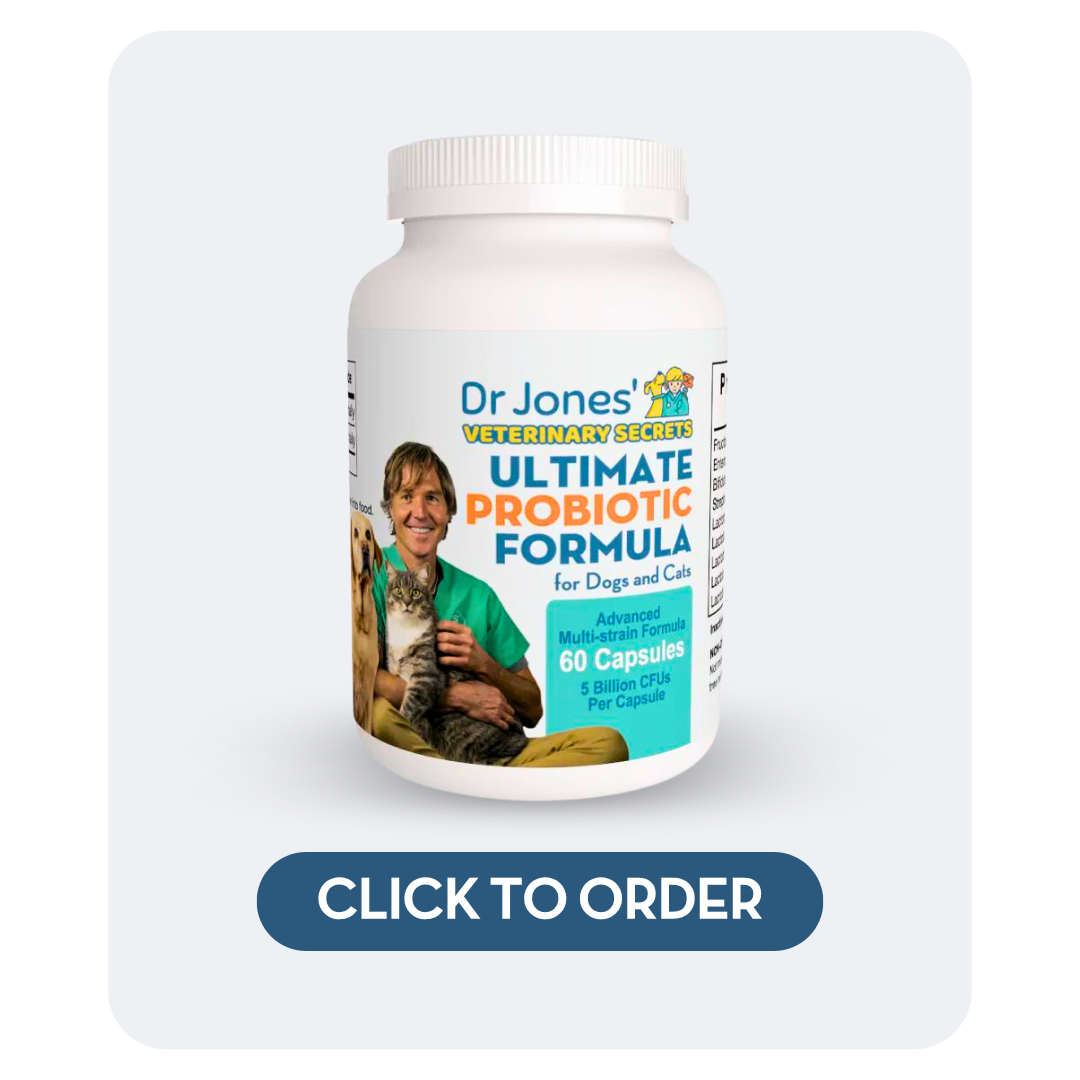Cat Flu Relief: 5 Natural Home Remedies to Help Your Feline
![]()

Holistic Remedies for Cat Flu: A Personal Guide
If you’re noticing your cat sneezing, with runny eyes and a stuffy nose, you’re probably wondering, “Does my cat have a cold or the cat flu?" Let me break it down for you. In this article, I’ll share some insights into what the cat flu is, what causes it, and—most importantly—how you can naturally help your feline friend recover and prevent future flare-ups.
Why Choose Dr. Jones’ Ultimate Feline for Your Cat?
Dr. Jones’ Ultimate Feline is specially designed to support your cat’s overall health, ensuring they live a long, happy, and active life. This holistic formula works in several ways to improve your cat’s well-being. It alleviates recurrent episodes of diarrhea and vomiting, supports digestive health, and promotes healthy mobility and joint function, especially important for aging cats. This formula offers safe, supportive care, helping to manage aging symptoms. Dr. Jones’ Ultimate Feline is a must-have for your cat’s long-term health and happiness.


What is the Cat Flu?
The most common signs of the cat flu are a runny nose, swollen, watery eyes, and sneezing. Your cat may also become lethargic and lose interest in food or water. Unfortunately, the cat flu tends to be recurring for many cats. You’ll often see repeated bouts of sneezing, runny eyes, and congestion.
The culprits behind cat flu are two main feline viruses: Feline Herpesvirus (also known as Feline Viral Rhinotracheitis) and Feline Calicivirus. Some cats may carry these viruses from kittenhood, making them susceptible to frequent flare-ups. While it may sound worrying, the good news is that most cases resolve on their own in 7-10 days with supportive care.
What Can You Do at Home?
Before diving into at-home remedies, it’s important to first make sure your cat is eating and drinking. If your cat refuses food or water for more than 48 hours, this can lead to serious liver issues like hepatic lipidosis. So, make sure your cat is at least staying hydrated and nibbling on food. If they are, here’s what you can try at home:
1. Boost Immune System with Food
One of the easiest ways to help your cat recover is by making sure they’re eating. You can try warming up their favorite canned food to make it more enticing. If that doesn’t work, add a tiny amount of garlic (about 1/8 teaspoon) to their food. If your cat still isn’t eating, you can offer them canned tuna to tempt their appetite.
2. Humidity to Ease Congestion
Humidity is incredibly helpful when it comes to easing nasal congestion. This simple remedy can improve your cat’s breathing and help them feel more comfortable. You can use a humidifier or create a steam room by running a hot shower and letting your cat sit in the bathroom for a while.
3. Clear Nasal Passages and Eyes
A damp cloth can help wipe away any crusted discharge around your cat’s nose and eyes. If your cat is suffering from severe nasal congestion, I’ve often used Pediatric Otrivin to clear blocked airways. Just put one drop in each nostril, three times a day, for 3-5 days.
4. Herbal Remedies for Respiratory Support
There are two herbs I swear by for treating respiratory infections in cats: Echinacea and Lemon Balm. Echinacea is particularly important because it can help boost your cat’s immune system. The dosage I recommend is 1-2 drops per pound of your cat’s weight, three times daily using an alcohol-free tincture. Use this for no more than two weeks.
Lemon balm, with its antiviral properties, can also be helpful. A dose of 500 mg twice a day should suffice.
5. Lysine: The Game-Changer
Finally, let me tell you about L-lysine, an amino acid that’s proven to be an effective antiviral treatment. It’s especially helpful for cats with recurrent Herpes Virus infections. L-lysine is available in veterinary pastes like Enisyl and as a supplement in my Dr. Jones’ Ultimate Feline Health Formula. The dose is 1 ml (250 mg) twice a day for at least 12 weeks to help prevent the virus from recurring.

Final Thoughts
If your cat has the cat flu, the remedies I’ve outlined here can be a big help. Start by ensuring that your cat is eating and drinking—if they’re not, seek veterinary help right away. A humidifier, Pediatric Otrivin, and L-lysine can all work together to ease congestion, improve their health, and prevent future flare-ups.
Remember, if the symptoms persist or worsen, don’t hesitate to contact your vet. But with these natural remedies, your cat should be on the road to recovery in no time.
Stay healthy, and take good care of your furry friend!
Why Choose Dr. Jones’ Ultimate Feline for Your Cat?
Dr. Jones’ Ultimate Feline is specially designed to support your cat’s overall health, ensuring they live a long, happy, and active life. This holistic formula works in several ways to improve your cat’s well-being. It alleviates recurrent episodes of diarrhea and vomiting, supports digestive health, and promotes healthy mobility and joint function, especially important for aging cats. This formula offers safe, supportive care, helping to manage aging symptoms. Dr. Jones’ Ultimate Feline is a must-have for your cat’s long-term health and happiness.










I had a lot of Advise,thank you that will help.Just in case.
I had 5 Cat’s I rescue. Most are born in my House.
I lost 2 almost at the same time last Year,it hurt so much.I still take care of the Mommy Cat here daughter,and my other rescue.I love them all.I do had an incident when I got so called the Flu,( I had a shot) but all my two Cat’s got sick.I was so shocked.I like to read your E-mails and Advise thank you kindly; Roswitha
Where do you find echinacea and lemon balm for cats? Mine have the flu, but I can’t find any.
I couldn’t find echinacea and lemon balm for cats. Can you use echinacea and lemon balm for humans on cats?
I use human remedies on my cats and dogs, just none with an alcohol base. I give them lysine by opening a gel cap and mixing half if it with mashed cooked chicken liver, they love it! Make a strong tea of echinacea and lemon balm…altho echinacea tastes bad so might be hard to get a cat to eat it…unless well mixed with liver? I take lysine myself all winter to prevent colds and such, its amazing stuff. I can always tell when my immune system needs it.
Thanks for sharing
This is 1 month old kitten that I am trying to get back to health here and mommy cat not the best, has another she is nursing and keep healthy. She has a very hard time having healthy kittens at birth, she has lost so many. Still born of they made it that far. I will have her fixed after nursing. She is a rescue. I have a hard time on my disability and trying to care for all these animals people have dropped off outside of my trailer is a stop sign and people drop off animals there. I have 12 dogs and 7 cats (HELP!), I love them all had 5 fixed today. Thanks so much for me being sponsored last month and this month all a fix except mommy and nursing babies and Brindie is to sick to get fixed now due to flea allergies. But they helped.me with that today. Thank you please tell me what to do with a1month old kitten with eyes and nose clogged shut and mommy cat not taking care of the kittie because taking care of the other one
For a 1-month-old kitten with clogged eyes and nose, especially when the mother is not able to care for it, the following remedies may help:
Wipe the eyes and nose: Use a damp cloth to gently clean the kitten’s nose and eyes of any crusted discharge.
Humidifier: To ease congestion, place the kitten in a steamy bathroom or use a humidifier to help with breathing.
Pediatric Otrivin: For severe nasal congestion, one drop of pediatric Otrivin in each nostril can be used 3 times a day for 3-5 days (consult a vet for precise dosage).
Herbal remedies: Echinacea (1-2 drops per pound, alcohol-free tincture) and lemon balm (500 mg twice daily) can support the kitten’s immune system.
Please help don’t want to lose 1 month old kitten